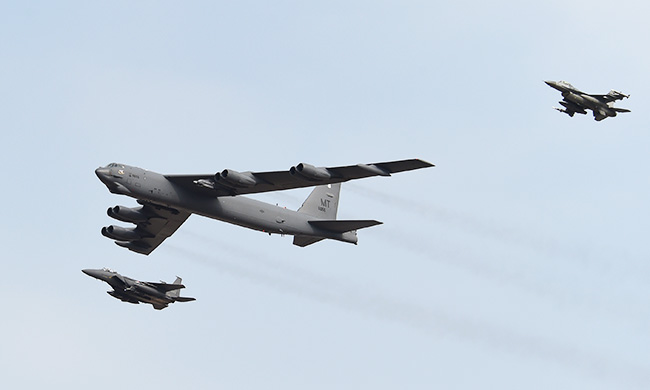- California Assembly OKs highest minimum wage in nation
- S. Korea unveils first graphic cigarette warnings
- US joins with South Korea, Japan in bid to deter North Korea
- LPGA golfer Chun In-gee finally back in action
- S. Korea won’t be top seed in final World Cup qualification round
- US men’s soccer misses 2nd straight Olympics
- US back on track in qualifying with 4-0 win over Guatemala
- High-intensity workout injuries spawn cottage industry
- CDC expands range of Zika mosquitoes into parts of Northeast
- Who knew? ‘The Walking Dead’ is helping families connect
B-52 bomber flies over Korea

A B-52 strategic bomber, escorted by South Korea’s F-15K and the U.S. Air Force’s F-16 fighter jets, flies over an air base in Osan, Gyeonggi Province, Sunday. The B-52 bomber, armed with nuclear missiles and “bunker buster” bombs, left U.S. Andersen Air Force Base in Guam on Sunday morning and arrived in Osan at noon as a show of force against North Korea. (Yonhap)
SEOUL/WASHINGTON (Yonhap) — The United States’ B-52 Stratofortress strategic bomber flew in the skies of South Korea on Sunday in a major show of force four days after North Korea conducted what it said was its first hydrogen bomb test.
The B-52 bomber left U.S. Andersen Air Force Base in Guam on Sunday morning and arrived in the skies above Osan, Gyeonggi Province, at noon, armed with nuclear missiles and “bunker buster” bombs that are capable of bombarding North Korea’s underground facilities, according to Seoul and Washington.
The bomber flew low past the Osan air base, flanked by an entourage of two South Korean F-15Ks and two U.S. F-16s before returning to its home base, the two sides’ militaries said.
The deployment was made as part of a series of military counteractions taken after the North announced the nuclear test on Wednesday.
Two days after the test, South Korea resumed its anti-North loudspeaker broadcasts along the inter-Korean border, designed to agitate front-line North Korean soldiers.
South Korea had previously blared criticisms of the North Korean regime — in addition to radio soap operas and K-pop music — after a land mine planted by the North maimed two South Korean soldiers in the Demilitarized Zone (DMZ) in August.
The broadcasts were stopped later that month after the two sides agreed to diffuse military tensions and resume reunions of family members separated by the 1950-53 Korean War.
North Korea also started its own loudspeaker broadcasts later Friday, which appear to be aimed at washing out the South Korean messages, according to a South Korean military official.
The strategic bomber is part of a “nuclear umbrella” the U.S. provides to the Northeast Asian ally.
“The speedier-than-expected deployment could indicate signs of the U.S.’ intention that it will retaliate severely if the North makes further provocations,” a South Korean military official said.
Officials said the B-52 is capable of bombing North Korea’s military commanding facilities from a location some 3,000 kilometers away and it takes only four hours for the U.S. to bring the bomber from the Guam base to the Korean Peninsula.
South Korea and the U.S. plan to take further military counteractions down the road in the aftermath of the recent nuclear test, officials said.
Sources indicated the plans may include additional deployments of the U.S. nuclear-powered USS Ronald Reagan aircraft carrier, currently based in Yokosuka, Japan, a nuclear submarine and the F-22 stealth tactical fighter Raptor in South Korea.
South Korea and the U.S. are scheduled to carry out the naval portion of the Foal Eagle exercise in March, but they are considering moving it to an earlier date, the sources said.
Stationing such strategic U.S. assets on the peninsula is a major means of deterrence, which South Korea and the U.S. have often used against North Korea’s military actions.
Hours after the North’s test on Wednesday, U.S. Defense Secretary Ashton Carter committed “every means of extended deterrence” for the defense of South Korea against North Korea’s nuclear and missile threats.
“The flight today demonstrates the strength and capabilities of the alliance,” U.S. Forces Korea commander Gen. Curtis Scaparrotti said. “The close military cooperation between the U.S. and South Korea ensures we are ready to respond at any time to those who would threaten stability and security.”
The flight of the B-52 “demonstrates one of the many alliance capabilities available for the defense of the Republic of Korea,” Lt. Gen. Terrence O’Shaughnessy, USFK deputy commander and U.S. Seventh Air Force commander, said after the flight.
In a press statement in Washington, U.S. Pacific Command Adm. Harry B. Harris Jr. said, “This was a demonstration of the ironclad U.S. commitment to our allies in South Korea, in Japan and to the defense of the American homeland.”
“North Korea’s nuclear test is a blatant violation of its international obligations. U.S. joint military forces in the Indo-Asia-Pacific will continue to work with all of our regional allies and partners to maintain stability and security,” he said.
North Korean leader Kim Jong-un has defended the claimed H-bomb test as an act of self-defense in his first open remark on the matter, the Korean Central News Agency (KCNA) reported Sunday.
“The DPRK’s H-bomb test, conducted at the outset of the year … is a self-defensive step for reliably defending the peace on the Korean Peninsula and the regional security from the danger of nuclear war caused by the U.S.-led imperialists,” Kim was quoted as saying by the North’s state-run KCNA. DPRK is the acronym for North Korea’s official name, the Democratic People’s Republic of Korea.
He was speaking to the Ministry of People’s Armed Forces at an event for the new year, the KCNA said.
South Korea and the U.S., however, say the blast observed last week is too weak to have originated from a full-fledged H-bomb.
Earlier Sunday, the official newspaper of the North’s ruling Workers’ Party of Korea ran a curiously well-timed editorial condemning the deployment of U.S. strategic bombers on the Korean Peninsula.
The U.S. “is going crazy with its military exercises in Korean waters using aircraft carriers and nuclear-armed submarines that are aimed at conquering Pyongyang,” the Rodong Sinmun said Sunday.
The newspaper was published before Seoul and Washington announced its B-52 deployment, but it still reflects Pyongyang’s apprehension of the possible deployment of U.S. strategic weapons in Korea.
China expressed its “firm” opposition to North Korea’s H-bomb test in its immediate aftermath. But two days later, it regressed to its previous equivocal stance by saying it doesn’t hold the “key” to the North Korean nuclear program.
Foreign minister Yun Byung-se said Sunday China must prove its firm opposition to North Korea with action.
“The Chinese government must clearly follow through with its promise made to the international community when it votes for the United Nations Security Council resolution,” Yun said on “Sunday Diagnosis,” a KBS current affairs program, on Sunday morning. “That’s important to stabilizing the Korean Peninsula, Northeast Asia and the international community. It would prove that China hasn’t made empty promises.”
















horangih
January 11, 2016 at 9:24 AM
Given that massive US bombing of civilians killed millions of Koreans, do we want to see this again?
Another Holocaust from the skies?
https://www.youtube.com/watch?v=31wy85JcWPA
Pingback: Central International Law Firm South Korea | local info cheap lawyer desk
Pingback: Yokosuka Base Housing Floor Plans | super decorating ideas